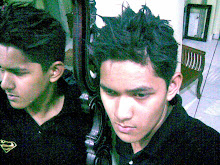


WHAT IS MILLING?

Milling is the process of cutting away material by feeding a workpiece past a rotating multiple tooth cutter. The cutting action of the many teeth around the milling cutter provides a fast method of machining. The machined surface may be flat,angular, or curved. The surface may also be milled to any combination of shapes. The machine for holding the workpiece, rotating the cutter, and feeding it is known as the Milling machine.
View a typical milling operation. This movie is from the MIT-NMIS Machine Shop Tutori
al
CLASSIFICATION OF MIL
LING
· Peripheral Milling
In peripheral (or slab) milling, the milled surface is generated by teeth locate

d on the periphery of the cutter body. The axis of cutter rotation is generally in a plane parallel to the workpiece surface to be
machined.

(Kalpakjian S., Introduction to Manufacturing Processes)
· Face Milling
In face milling, the cutter is mounted on a spindle having an axis of rotation perpendicular to the workpiece surface. The milled surface results from the action of cutting edges located on the periphery and face of the cutter.
· End Milling
The cutter in end milling generally rotates on an axis vertical to the workpiece. It can be tilted to machine tapered surfaces. Cutting teeth are located on both the end face of the cutter and the periphery of the cutter body.
METHODS OF MILLING
· Up Milling
Up milling is also referred to as conventional milling
. The direction of the cutter rotation

opposes the feed motion. For example,
if the cutter rotates clockwise , the workpiece is fed to the right in up milling.

(Boothroyd G. & Knight W., Fundamentals of Machining and Machine Tools)
· Down Milling
Down milling is also referred to as climb milling. The direction of cutter rotation is same as the feed motion. For example, if the cutter rotates counterclockwise , the workpiece is fed to the right in down milling.

(Boothroyd G. & Knight W., Fundamentals of Machining and Machine Tools)
The chip formation in down milling is opposite to the chip formation in up milling. The figure for down milling shows that the cutter tooth is almost parallel to the top surface of the workpiece. The cutter tooth begins to mill the full chip thickness. Then the chip thickness gradually decreases.

Other milling operations are shown in the figure.
Milling: Introduction  Milling is as fundamental as drilling among powered metal cutting processes.
Milling is as fundamental as drilling among powered metal cutting processes.
Milling is versatile for a basic machining process, but because the milling set up has so many degrees of freedom, milling is usually less accurate than turning or grinding unless especially rigid fixturing is implemented.
For manual machining, milling is essential to fabricate any object that is not axially symmetric. There is a wide range of different milling machines, ranging from manual light-duty Bridgeports™ to huge CNC machines for milling parts hundreds of feet long. Below is illustrated the process at the cutting area.

Milling: Column-and-Knee Manual Mill  Below is illustrated a typical column-and-knee type manual mill. Such manual mills are common in job shops that specialize in parts that are low volume and quickly fabricated. Such job shops are often termed "model shops" because of the prototyping nature of the work.
Below is illustrated a typical column-and-knee type manual mill. Such manual mills are common in job shops that specialize in parts that are low volume and quickly fabricated. Such job shops are often termed "model shops" because of the prototyping nature of the work.

The parts of the manual mill are separated below. The knee moves up and down the column on guideways in the column. The table can move in x and y on the knee, and the milling head can move up and down.


















